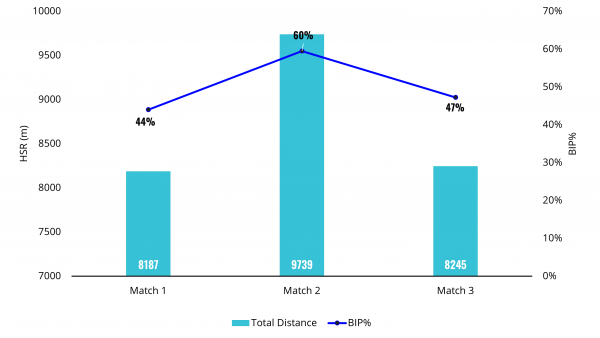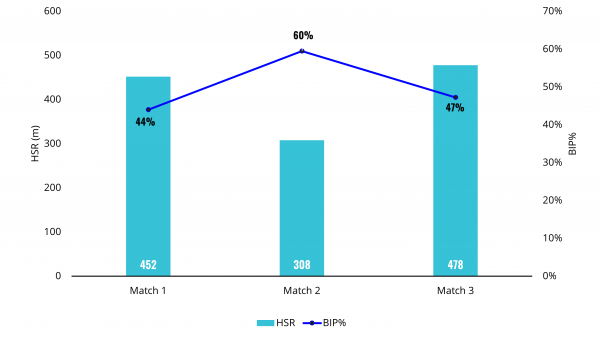
03 Dec Ball in Play Collection Made Easy with Sonra Live
INTRODUCTION
GPS has become an integral tool in investigating match demands in sport, with training aiming to prepare players for these demands [1].
Research conducted to date has often not accounted for a key aspect relevant to match demands that players face, by including the time when the ball is in/not in play [2].
Periods of ball-in-play (BIP) have been found to account for ∼57% of total match time, in a study of 18 matches which included over 200 players [3].
Recent research into the match demands of football, whilst the ball is in play, has indicated that the average match demands increase during BIP periods, compared to whole match data [1, 2, 3].
For professional footballer players, average BIP demands were significantly higher than average whole match demands for distance per minute (128m ± 15.4 to 88.5m ± 13), high-speed running (HSR) distance per minute (16.9m ± 4.6 to 8.6m ± 1.9), and high metabolic load (HML) distance per minute (29.7m ± 6.1 to 16.3m ± 3.1) [1].
The same correlation was found with when analysis was conducted with a group of elite academy players with higher intensity metrics occurring in matches with a higher BIP % [3].
Physical demands during BIP periods have previously been investigated in other sports, such as rugby union, rugby league and hurling, with each study reporting significant differences between average match demands and BIP demands for distance per minute and HSR per minute [4, 5, 6].
SONRA LIVE: BALL-IN-PLAY
Through the Sonra Live iPad app, we can record BIP percentage in a real-time manner, without the need for time-consuming post-match analysis.
Recording the BIP percentage across the entire session and individual drills provides context for physical outputs across multiple drills and matches.
This information can then be used in training planning, by designing drills to ensure that their team is physically prepared to meet or exceed potential match demands.
Using BIP to design drills may be useful in sessions leading up to match day (MD).
For example, drills with a higher BIP percentage may be included in MD-4 sessions, where the aim is to increase physical load.
In sessions closer to matches, such as MD-2, the user may include drills with a lower BIP percentage, such as set-piece drills.
UTILISING THE BIP FEATURE IN SONRA
BIP is an easy-to-use feature integrated into the Sonra Live app.
In order to activate the BIP function on the Sonra Live app, the feature must first be toggled on in the Sonra Desktop app, then synced to the iPad app.
This can be done as follows:
Settings –> Live –> Enable Ball in Play –> Toggle on
Once Ball in Play has been enabled in the Sonra desktop settings, all future live sessions will have the feature enabled after syncing to the iPad.
Video 1. Enabling BIP feature for Live in Sonra.
- On the Sonra Live iPad app, begin a session as normal. BIP can be toggled on and off at the top of the screen.
- Total BIP time will be visible at the top of the screen, while BIP percentage for individual drills can be seen on the drill dashboard.
Video 2. Utilizing BIP feature on Sonra Live.
BIP data is synced across to the desktop when syncing created drills. This is then applied to drills and further drills cut post-download.
ANALYSIS
Thirteen semi-professional male soccer players from a Northern Irish Football League (NIFL) squad, were analysed over 3 in-season competitive matches.
Only players who played a minimum of 60 minutes were included in the investigation.
Across the 3 matches, BIP periods accounted for an average of 51% of total match time.
The BIP percentages differed greatly from match 2 (60%) to match 1 (44%) and match 3 (47%).
Total Distance, HSR Distance, and HML Distance were analysed across the individual matches.
Total Distance covered was highest in match 2 (9739 m), with match 1 and 3 producing considerably lower Total Distance (see figure 1).

Figure 1. Total Distance and BIP% values across matches.
In contrast, however, HSR distance was lowest in match 2 (308 m), as seen below (Figure 2).

Figure 2. HSR and BIP% values across matches.
Although total match time and BIP percentage differed across the 3 matches, match intensities remained relatively consistent (see Table 1).
Match intensity was displayed using 3 metrics – distance per minute, HSR distance per minute, and HML distance per minute.

Table 1. Intensity markers (BIP%, Distance/m, HSR/m & HMLD/m) across matches.
PRACTICAL APPLICATIONS
Recording BIP is a useful tool for providing context for match demands in soccer.
In matches with a higher BIP percentage, users can expect to see a higher total distance covered across the team.
This may have implications for training load monitoring, for example, allowing adequate post-match recovery due to the increased match load.
Collecting match BIP data allows the user to replicate BIP periods in training, through small-sided games, for example.
Practitioners may introduce set-pieces to lower the BIP percentage, allowing the team to recover and organise between BIP periods.
Users can also utilise the BIP feature to design drills based on the playing style of the team.
For example, users may implement drills with a high BIP percentage in order to replicate a high tempo playing style.
To do this, set pieces may be removed from drills, or ‘feeder roles’ are assigned to coaches or players to ensure the ball is returned to play as quickly as possible to maintain a higher BIP percentage.
The BIP feature may also be applied in the return-to-play phase of rehab, as it allows the user to periodically increase the session volume and intensity, with the aim of eventually exposing the player to match demands.
Drills may be created by the user based on match BIP periods, including rest periods to mimic a match scenario.
Author Details
Naoise Leonard
Account Manager – Sports Scientist
REFERENCES
- Mernagh, D., Weldon, A., Wass, J., Phillips, J., Parmar, N., Waldron, M. and Turner, A. (2021) ‘A Comparison of Match Demands Using Ball-in-play Versus Whole Match Data in Professional Soccer Players of the English Championship’, Sports, 9(6), 76
- Wass, J., Mernagh, D., Pollard, B., Stewart, P., Fox, W., Parmar, N., Jones, B., Kilduff, L. and Turner, A.N. (2020) ‘A Comparison of Match Demands Using Ball-in-play vs. Whole Match Data in Elite Male Youth Soccer Players’ Science and Medicine in Football, 4(2), 142-147
- Riboli, A., Semeria, M., Coratella, G. and Esposito, F. (2021) ‘Effect of Formation, Ball-in-play and Ball Possession on Peak Demands in Elite Soccer’, Biology of Sport, 38(2), 195
- Pollard, B.T., Turner, A.N., Eager, R., Cunningham, D.J., Cook, C.J., Hogben, P. and Kilduff, L.P. (2018) ‘The Ball-in-play Demands of International Rugby Union’, Journal of Science and Medicine in Sport, 21(10), 1090-1094
- Gabbett, T.J. (2015) ‘Influence of Ball-in-play Time on the Activity Profiles of Rugby League Match-Play’, The Journal of Strength & Conditioning Research, 29(3), 716-721
- Young, D., Hennessy, L. and Coratella, G. (2021) ‘The Ball-in-play Vs. Ball-out-of-play Match Demands of Elite Senior Hurling’, Sport Sciences for Health, 1-10